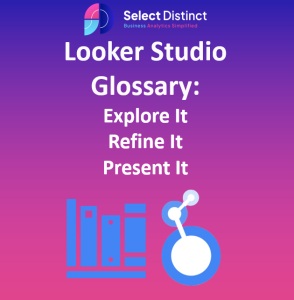Looker Studio Glossary

Clear Definitions of Key Looker Studio Terms
Explore the Looker Studio glossary below. Each term is listed individually for easy reference and future expansion with examples or best practices.
Categories
1. Core Concepts
Report
A canvas for visualizing data. Reports contain pages, charts, controls, and text elements to communicate insights.
Component
Any visual or interactive element added to a report — including charts, tables, filters, and text boxes.
Page
A section within a report. Reports can have multiple pages to organize content by theme or audience.
Canvas Size
Defines the dimensions of the report layout. Can be customized for screens, print, or embedded views.
2. Data Sources & Connectors
Connector
A tool that links Looker Studio to external data (e.g., Google Analytics, BigQuery, Sheets). Can be native or community-built.
Data Source
A configured instance of a connector. Defines available fields, schema, and access settings.
Community Connector
A third-party connector built using Looker Studio’s API. Enables integration with non-Google platforms.
Data Control
A report-level setting that lets viewers switch between data sources dynamically.
Credentials
Determines how data is accessed — either using the viewer’s credentials or the report owners.
3. Charts & Visualisations
Bar Chart / Line Chart / Pie Chart / Area Chart / Combo Chart
Standard visualizations for comparing values, trends, and proportions.
Bullet Chart
Displays performance against a target. Useful for KPIs and benchmarks.
Table
Displays raw data in rows and columns. Supports sorting, pagination, and conditional formatting.
Scorecard
Shows a single metric value, often used for highlighting KPIs.
Community Visualisation
Custom visual elements built using JavaScript and Looker Studio’s visualization API.
4. Fields & Calculations
Dimension
Qualitative data used to group or segment metrics (e.g., country, category, device).
Metric (Measure)
Quantitative data used for calculations (e.g., revenue, sessions, clicks).
Calculated Field
A custom field created using formulas. Can combine dimensions and metrics or apply logic.
Formula
The expression used in a calculated field. Supports functions, operators, and conditional logic.
Parameter
A user-defined input that can be used in formulas or filters. Enables dynamic report behaviour.
Table Calculation
A formula applied directly within a chart, allowing quick transformations without editing the data source.
5. Filters & Controls
Filter Control
An interactive element that lets viewers filter data (e.g., dropdowns, sliders, checkboxes).
Date Range Control
Allows users to select a time period for the report or specific charts.
Linked Filters
Filters that apply across multiple charts or pages. Can be inherited or scoped.
Cross-Filtering
Enables charts to act as filters for other charts. Improves interactivity and exploration.
Drill Action
Allows users to click into a chart to explore deeper levels of data (e.g., category → subcategory).
6. Report Settings & Performance
Cache
Stores query results temporarily to improve performance. Can be refreshed manually or automatically.
Data Freshness
Indicates how recently the data was updated. Controlled by connector settings and cache behaviour.
Current Page Settings
Controls layout, filters, and visibility for the active report page.
Arrange
Layering and alignment tools for organizing components on the canvas.
7. Access & Sharing
Viewer Credentials
Uses the viewer’s access rights to retrieve data. Ensures personalized and secure data access.
Owner Credentials
Uses the report creator’s access rights. Ensures consistent data across viewers.
Roles & Permissions
Define who can view, edit, or share reports and data sources.
Get Involved:
Suggest Terms & Request Clarification
Help Us Make the Glossary Even Better
We’re committed to keeping our glossary comprehensive and up to date, but we know there’s always room for improvement. If you’ve come across a term that’s missing or need further explanation on any topic, we’d love to hear from you.
Suggest a New Term
Have a technical phrase or concept you think should be added? Let us know! Your input helps us ensure the glossary remains useful to everyone in the community.
Request Clarification
If you find any definition unclear or would like more examples, feel free to request clarification. We aim to provide clear, practical insights for all users.
Share Your Feedback
- Email your suggestions directly
- Fill in our feedback form
Thank you for helping us build a better resource for everyone!
